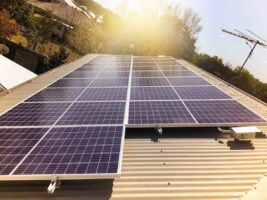The federal Coalition government has sought to make it harder for any future government to change the current low-ball emissions targets, seeking to lock in a policy that seeks to stop new renewable energy investment in its tracks.
Climate policy expert Erwin Jackson, from Environment Victoria, says an option to change the government’s current target with five years notice has been removed from the proposed National Energy Guarantee.
Instead, it seeks to lock in is target until 2030, and would allow no changes to be made until 2025, although these would not take effect until 2031-35.
The revelation comes as the Coalition government seeks to calm concerns from the right wing of its party, led by former prime minister Tony Abbott, who argue that the NEG – and its proposed 26 per cent cut in emissions – goes too far, and should be “back-loaded”.
But analysts say this attempt to stop any action in coming years is moot, because the target for the electricity sector is so weak that much of it will be met by 2020 anyway, because of all the wind and solar being built under the renewable energy target that Abbott tried to destroy.
And it begs the question, if the NEG has been designed as the only thing acceptable to the likes of Abbott, Craig Kelly, and Barnaby Joyce and co, and they don’t like it, then why bother?
The only policy incentive for new investment in wind and solar will come through the state-based targets in Victoria and Queensland.
Worse, analysts say that the outline of the mechanism prepared by the Energy Security Board appears designed to penalise those retailers who “over-achieve” on their emissions. i.e. if they build too many wind and solar plants.
On top of this, the ESB proposes to include any efforts by individual households to reduce emissions through their own rooftop solar in the overall calculations.
That means that retailers can use the rooftop solar of household customers to reduce their own emissions intensity, and unless the household goes off-grid, their efforts won’t add to the legislated target.
The situation underlines the quiet, and not-so-quiet, fury among states and analysts over the design and intent of the NEG, and the Coalition efforts to do all it can to remove any incentive for new clean energy investment.
Analyst David Leitch on Tuesday wrote an eviscerating assessment, declaring it to be a “fraud” of a policy, a complex beast rushed together in a matter of weeks for a vote by state and territory ministers in August.
While the ESB is designing the mechanism of the proposed emissions and reliability guarantees, the federal government remains in charge of policy, which includes targets, access to offsets, and exemptions for trade exposed industries.
In previous iterations, the Coalition government said it would seek to lock in its target for 10 years, until 2030, but advised that any changes would require 5 years notice.
Jackson notes that in the government’s latest 20-page report to COAG energy ministers, reference to the 5 years notice is removed, and it suggests that any change could only occur in 2025. (See page 7 of that report)
“Business needs to know the rules of the game in terms of how the target can be changed, so they can factor that in to their decision making.”
Jackson says locking in low-ball targets for electricity means that the country’s cheapest abatement options will be ignored. So instead, the burden of meeting the overall Paris targets will fall on other sectors, such as transport, manufacturing and farming








